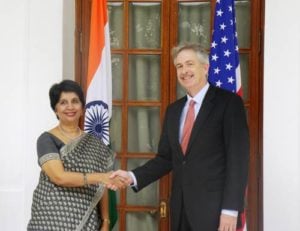
William J. Burns with his Indian counterpart, Nirupama Rao (Source: U.S. State Department)
My last post argued that, despite several positive developments, storm clouds about Afghanistan and Iran loom on the U.S.-India horizon. Time will tell how much turbulence these clouds churn up. But for the moment, it is worth noting the important conceptual shift that has occurred over the past few months in U.S. policy vis-à-vis New Delhi, heralded in two recent addresses by senior Obama administration officials.
In its first year, the administration largely eschewed the balance-of-power thinking that drove its predecessor’s strategic entente with India. Instead, President Obama emphasized high-profile engagement with Beijing on an array of global governance issues, including the world economy and climate change. Secretary of State Hillary Rodham Clinton explicitly rejected geopolitical balancing in favor of “tilting the balance away from a multipolar world toward a multi-partner world.” In U.S. foreign policy circles, talk of “G-2” cooperation and “Chimerica” filled the air. All of this had the effect of diverting strategic focus away from New Delhi.
But the efficacy of this strategy was called into deep question by the brusque treatment Mr. Obama received from Chinese leaders – both during his state visit to Beijing in mid-November 2009 and then at the global climate summit in Copenhagen a month later — not to mention growing U.S.-China strains over North Korea and Iran. In the last few months, the administration has reverted to Bush-era themes by moving to shore up U.S. alliances and friendships throughout Asia. (For an overview of these efforts, see Dan Blumenthal’s post last week on the web site of Foreign Policy magazine and his op-ed piece in today’s Wall Street Journal.) With regard to India, a signal change in policy direction was registered in two recent speeches, both of which resonated with themes straight out of the Bush administration’s playbook.
The first address, titled “India’s Rise and the Promise of U.S.-Indian Partnership” (read the text here and view the video here), was delivered on June 1 by William J. Burns, the Under Secretary of State for Political Affairs. When the Bush administration launched its nuclear cooperation initiative five years ago, senior policymakers famously declared that the U.S. objective was to help “India become a major world power in the twenty-first century. We understand fully the implications, including military implications, of that statement.” Secretary of State Condoleezza Rice stressed that “we’re fully willing and ready to assist in [the] growth of India’s global power…which we see as largely positive.” The publicly-denied but widely-understood goal was to build up India’s strategic potential as a check against the rise of Chinese power.
In his remarks last month, Burns reiterated similar language, affirming that “India’s strength and progress on the word stage is deeply in the strategic interest of the United States” and that the Obama administration is “deeply committed to supporting India’s rise.” And for those worried that Washington only viewed India through the prism of the “Af-Pak” problem, Burns declared that “we attach great significance to India’s expanding role in East Asia and welcome our partnership across the region.” He then called for India’s greater diplomatic and military involvement in East Asia and for enhanced U.S.-Indian defense cooperation – ideas bound to irritate leaders in Beijing.
Earlier this month, Michele Flournoy, the Under Secretary of Defense for Policy, picked up these themes. In an address titled “Investing in the Future of U.S.-India Defense Relations” (read the text here and view the video here), she similarly proclaimed that “India’s success is very much in America’s national interest” and that “increasingly our specific security interests are converging.” Like Burns, she sought to assuage concerns that the Obama administration solely viewed New Delhi as a sub-continental power, announcing that the U.S. “maintains a strong interest in India’s emergence as a regional power in Asia” and that “it no longer makes sense to discuss this increasingly interconnected region in terms of ‘East Asian’ security, or ‘South Asian’ security.” She then went on to call for the further development of bilateral military ties and promised that Washington would provide India “with top-of-the-line technology.”
Over time the expansion of Chinese power will undoubtedly push Washington and New Delhi into a tighter strategic embrace, as the remarks by Burns and Flournoy demonstrate. But as evidenced by the growing differences over policy in Afghanistan and Iran, the process will not be self-propelling and will encounter inevitable frictions. The question now is which plot line will be most visible during President Obama’s state visit to India this fall.